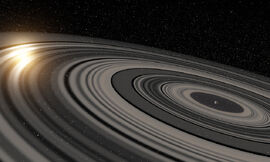J1407b is the first exoplanet or brown dwarf discovered with a ring system by the transit method.

An artist's impression of J1407b.
A sequence of occultations of the star 1SWASP J140747.93-394542.6 occurred over a 56-day period in 2007. The pattern was consistent with that expected for the transit of a large system of multiple rings, associated with a substellar companion dubbed “J1407b”. The J1407b ring system has an outer radius of about 90 million km (about 640 times the one of Saturn’s rings). The team found cleared gaps in the rings, which indicate that satellites (“exomoons”) may have formed and accreted from the material orbiting J1407b. However, the young age of the stellar system (only about 16 million years) and the high mass of the ring system (roughly an Earth mass) are more consistent with it being a circumplanetary or protoexosatellite disk in the process of forming satellites, rather than a long-term stable ring system in an evolved planetary system (such as Saturn's rings).
From Earth's point of view, the ring system appears about 3.7 milliarcseconds across. For comparison, if it were the same distance from our solar system Saturn's ring system would be 0.0000000006 milliarcseconds across.